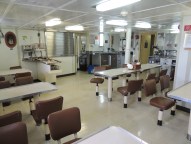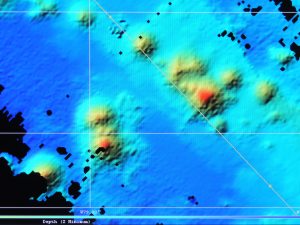NOAA Teacher at Sea
Dana Chu
On Board NOAA Ship Bell M. Shimada
May 13 – 22, 2016
Mission: Applied California Current Ecosystem Studies (ACCESS) is a working partnership between Cordell Bank National Marine Sanctuary, Greater Farallones National Marine Sanctuary, and Point Blue Conservation Science to survey the oceanographic conditions that influence and drive the availability of prey species (i.e., krill) to predators (i.e., marine mammals and sea birds).
Geographic area of cruise: Greater Farallones, Cordell Bank, and Monterey Bay National Marine Sanctuaries
Date: Tuesday, May 17, 2016
Weather Data from the Bridge
Clear skies, light winds at 0600 increased to 18 knots at 0900, 6-8 feet swells
Science and Technology Log
Ahoy from the Bell Shimada! Today, I will explain three of the tools that are deployed from the side deck to obtain samples of the water and the ocean’s prey species.
First off we have the Harmful Algal Bloom Net, also known as the HAB Net, which is basically a 10-inch opening with a 39-inch fine mesh netting attached to a closed end canister. The HAB net is deployed manually by hand to the depth of 30 feet three consecutive times to obtain a water sample. The top fourth of the water collected is decanted and the remaining water (approximately 80ml) is transferred to a bottle which is then sealed and labeled with the location (latitude, longitude), date, time, vertical or horizontal position, and any particular comments. The samples will eventually be mailed off to California Department of Health Services lab for analysis for harmful toxins from algae that can affect shellfish consumers.
Next we have the hoop net, which is pretty much similar in design to the HAB net, except for a larger opening diameter of 3 feet (think hula hoop) and a net length of nine feet. The net tapers off into a closed container with open slits on the sides to allow for water drainage. The purpose of the hoop net to collect organisms that are found at the various depth levels of the deployment. The hoop net is attached to a cable held by the winch. The hoop net is lowered at a specific angle which when calculated with the speed of the vessel equates to a certain depth. The survey crew reports the wire angle sighting throughout the deployment.
Every time the hoop net is brought back up there is a sense of anticipation at what we will find once the canister is open. Coloring is a good indicator. Purple usually indicates a high concentration of doliolids, while a darker color may indicate a significant amount of krill. Phytoplankton usually have a brownish coloring. Many of the hoop net collections from today and yesterday include doliolids and colonial salps, neither are very nutrient dense. Yesterday we also found pyrosomes, which are transparent organisms that resemble a sea cucumber with little bumps and soft thorns along their body. The smallest pyrosome we came upon was two and a half inches with the largest over six inches long. A few small fish of less than one inch in length also showed up sporadically in these collections as well.
The Scientific team is looking for the presence of krill in the samples obtained. The Euphausia pacifica is one of the many species of krill found in these waters. Many tiny krill were found in the various hoop net deployments. On the last hoop net deployment for today and yesterday, larger sized krill of approximately 1 inch) were found. This is good news because krill is the dominant food source for marine mammals such as whales. Ideally it would be even better if the larger krill appeared more frequently in the hoop net samples.
Finally, we have the Tucker Trawl, which is the largest and most complex of the three nets discussed in today’s post. The Tucker Trawl consists of three separate nets, one for sampling at each depth: the top, middle, and bottom of the water column. Like the hoop net, the tucker trawl nets also have a canister with open slits along the side covered with mesh to allow water to drain. All three nets are mounted on the same frame attached to a wire cable held by the winch. As the Tucker Trawl is towed only one net is open at a time for a specific length of time. The net is closed by dropping a weight down along the tow. Once the weight reaches the net opening, it triggers the net to shut and sends a vibration signal up the cable line back to the surface which can be felt by the scientist holding the cable. The net is then towed at the next depth for ten minutes. Once the last net tow has been completed, the Tucker Trawl is brought back up to surface. Similar to the hoop net, the survey tech reads the wire angle throughout the deployment to determine the angle the cable needs to be at in order for the net to reach a certain depth. This is where all the Geometry comes in handy!
As mentioned already, with three nets, the Tucker Trawl yields three separate collections of the nutrients found within the top, middle and bottom of the water column. Once the nets are retrieved, each collection container is poured into a different bucket or tub, and then into a sieve before making it into a collection bottle. If there is a large quantity collected, a subsample is used to fill up a maximum of two bottles before the remainder is discarded back into the ocean. Once the samples are processed, an outside label is attached to the bottle and an interior label is dropped inside the bottle, formalin is added to preserve the sample organisms collected so that they can be analyzed later back in the lab.
Personal Log
It is so good to finally get my sea legs! I am glad I can be of use and actively participate. Cooperative teamwork is essential to getting everything to flow smoothly and on time. The Bell Shimada’s deck crew and NOAA team work hand in hand with the scientists to deploy and retrieve the various instruments and devices.
In the past two days I am getting a lot of hands on experience with deploying the HAB net to assisting with processing samples from the HOOP Net and Tucker Trawl. It’s always exciting to see what we might have collected. I can’t wait to see what the rest of the week may bring. I wonder what interesting finds we will get with the midnight Tucker Trawl samples.
Lesson Learned: Neatness and accuracy are imperative when labeling samples! Pre-planning and preparing labels ahead of time helps streamline the process once the samples are in hand.
Word of the Day: Thermocline – This is the depth range where the temperature of the water drops steeply. The region above the thermocline has nutrient depleted waters and while the region below has nutrient rich waters.















































